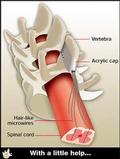13 November 1999,
Walking may be ambitious, but a neural amplifier could restore movement to many paraplegics
IMPLANTS that amplify weak signals travelling along the spinal cord might one day allow some paralysed people to stand or even walk. The researchers developing the implants have so far tested them only in animals, and are anxious not to raise false hopes. But they hope to begin clinical trials within two years.
In injuries in which the spinal cord isn't completely severed, the remaining neural pathways can let some weak signals through. As a result, about four in five people with spinal injuries still have some residual control over muscles in their legs. By boosting the faint signals responsible, Arthur Prochazka and his colleague Vivian Mushahwar of the University of Alberta in Edmonton, Canada, believe it may be possible to restore coordinated movements.
Movements such as walking aren't entirely controlled by the brain. Instead, once the brain has sent a signal to start walking, for instance, feedback loops between the motor nerves in the lower spinal cord and the sensory nerves in the muscles largely control the process. So, in theory, if the nerves beneath a spinal injury are undamaged and an implant boosts the signals coming down from the brain, these reflexes should take over.
To test this idea, Prochazka and Mushahwar have developed implants that can be attached directly to a vertebra. A series of microwires, made of an alloy of platinum and iridium, project from the implant and are fed individually into the spinal cord (see Diagram).
 |
| Implant to boost signals in the spinal cord |
The researchers tested the implants on four anaesthetised and four unanaesthetised cats, applying a signal of 300 microamps delivered between 25 and 40 times a second. By stimulating different parts of the spinal cord with different microwires, the researchers were able to get both groups of cats to flex their rear legs, and the unanaesthetised cats to raise the rear of their bodies to support their weight.
The unanaesthetised cats seemed so unconcerned by the experiment that they carried on eating. "One of the very important things about this is that the stimulation is apparently painless," says Prochazka. He also says that the microwires can be pulled out without damaging the spinal cord.
Other researchers have managed to trigger similar movements using electrical stimulation. But the real surprise came when Prochazka and Mushahwar turned down the amplitude of the signals from the implant to 50 micro-amps. These signals were too weak to cause muscle contraction directly. However, when the researchers monitored the electrical activity of the cats' muscles as they walked around, they found that the implants were causing the muscles to contract more strongly than normal, presumably by amplifying the natural impulses travelling along the spinal cord. The researchers have submitted a paper describing their results to the journal Experimental Neurology.
The cats in Prochazka and Mushahwar's experiments had no spinal injury. But if the implants can also amplify the weaker signals passing along a damaged spinal cord, it might be possible to restore movement to some paraplegics.
Prochazka is now planning human trials with the Alberta Paraplegic Foundation and the Alberta Heritage Foundation for Medical Research. The initial goal would be to help paralysed people stand and exercise their legs. "Walking with help from a frame could be possible in a couple more years," Prochazka cautiously predicts.
Other researchers warn that people shouldn't build up their hopes until the results from those trials are available. But they are impressed with Prochazka's approach. "It's a bit like jump-starting your car engine," says Richard Apps, a neurophysiologist at University of Bristol. "You give that extra oomph to the system."
Duncan Graham-Rowe